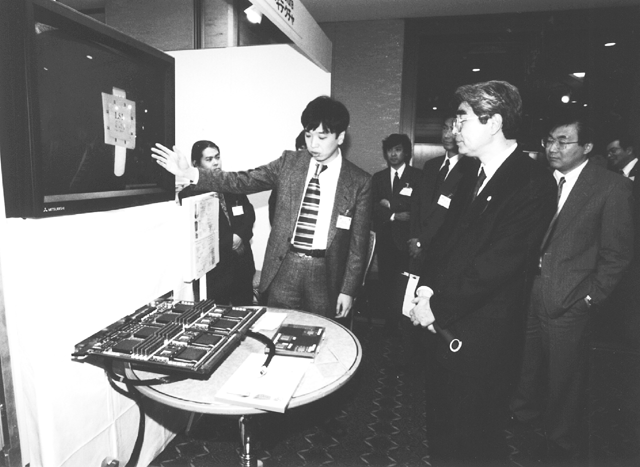
Demonstration by the TRC Massively Parallel Architecture Lab.
| Nobuki Kajihara C&C Lab. NEC Corp. |
Presentations on Massively Parallel Systems were conducted as demonstrations or poster presentations, as determined by the Program Committee. These presentations included 12 demonstrations (at 10 booths) and 3 poster presentations. The time allotted for each presentation was fixed, but the presenters remained at their respective booths for the rest of time, as instructed by the Program Committee. This may have been hard for the presenters since they were bound to their booths for a long time, however this restriction was good for visitors since they could thoroughly discuss particular issues with presenters whenever they preferred.
While the demonstrations on Theory and Novel Functions were straightforward, in a sense, except for those which were truly difficult, Massively Parallel Systems demonstrations may have been handicapped in terms of attracting the attention of visitors since it was hard to present them in an entertaining way.
I'll summarize the presentations on Massively Parallel Systems by dividing them into the following categories; architecture, system software, and applications.
The Massively Parallel Architecture Lab. of the RWC Tsukuba Research Center (hereafter TRC) gathered attention with a huge casing of a 64PE (Processing Elements) version of the RWC-1 parallel machine installed at a booth, just behind the entry to the demonstration site. RWC-1 is being developed as a demonstrative machine for parallel processing architecture with minimal communication overhead and fine granularity (unit of problem division). Regrettably, the processor chips were not mounted, but they will shortly be operating, so we can expect future evaluation.
The Massively Parallel Sanyo Lab. is developing a parallel file system for the RWC-1. This parallel file system features a dynamic load distribution during data writing so that access is not concentrated to one disk, and a distributed management system with multiple disk nodes.
The ETL group demonstrated image processing and a simulation of gaseous molecule movement by installing the parallel computer, EM-X.
The TRC Massively Parallel Software Lab. demonstrated as a research platform, a parallel machine of PC clusters connecting 32 PC boards with a high-speed network called Myrinet. Although this machine's communication throughput is inferior to the RWC-1 or the EM-X, this development implies a new direction of parallel machines which can be constructed relatively cheap.
The Massively Parallel NEC Lab, where I belong, built a prototype system using FPGA (Field Programmable Gate Array) as an architecture which is reconfigurable to problems, and demonstrated compilers and mapping real applications on it.

Demonstration by the TRC Massively Parallel Architecture Lab.
The TRC Massively Parallel Software Lab. demonstrated the computation of the Mandelbrot set and the tracking of moving portions in a captured image data of a toy train by installing a parallel OS, SCORE, on the above PC cluster. Two parallel languages were developed: MPC++ for system description and OCORE (Massively Parallel Toshiba Lab.) for application description. MPC++ is a powerful language which provides structures required for parallel processing as a library, which has flexible language extensions, and is expected to be a core language in parallel processing research.
The Massively Parallel MRI Lab. demonstrated the R-DB, a parallel debugger with a replay function using execution history. The University of Manchester demonstrated UFO, a language integrating functional and object-oriented paradigms. The Massively Parallel Toshiba Lab. demonstrated an environment which enables the development of parallel programs by combining components described in HPF via GUI.

Poster presentation(Massively Parallel TOshiba Lab.)
The Massively Parallel GMD Lab. and Nagoya University (poster) presented PROMOTER and NSL, application-oriented languages that execute problem description and automatic parallelization of numerical processing. They are developed on such platforms as MANNA (developed by GMD) and Cenju-3 (made by NEC). These are important studies for popularizing parallel processing with an approach to provide users with high performance, while making parallel processing invisible to users as much as possible.
The Massively Parallel Mitsubishi Lab. is developing OSim, a simulation tool for phenomena where many objects move around. It enables efficient parallel processing with their devised methods for synchronization and load balancing. They showed a simulation of transportation in Yokohama City. OSim may be promising as a new simulation method to simulate problems by representing them directly.
The Massively Parallel Mitsubishi Lab. and the Massively Parallel NEC Lab. (poster) presented a protein structure prediction as an application of massively parallel systems.
The Massively Parallel Mitsubishi Lab. proposed a technique which derives a minimum solution by defining approximate energy among constituent molecules of protein. The Massively Parallel NEC Lab. proposed a technique to combine statistical data on proteins with known structures and neural networks. TRC has also been working on genetic information processing as a core of parallel applications since FY1996, making me feel that genetic information processing will be an important application field in the future.
I have tried to mention many original accomplishments I found while attending the technical sessions of the Massively Parallel Systems, and I would like to conclude my report by stating that I look forward to further progress in the second-half of the RWC Project.